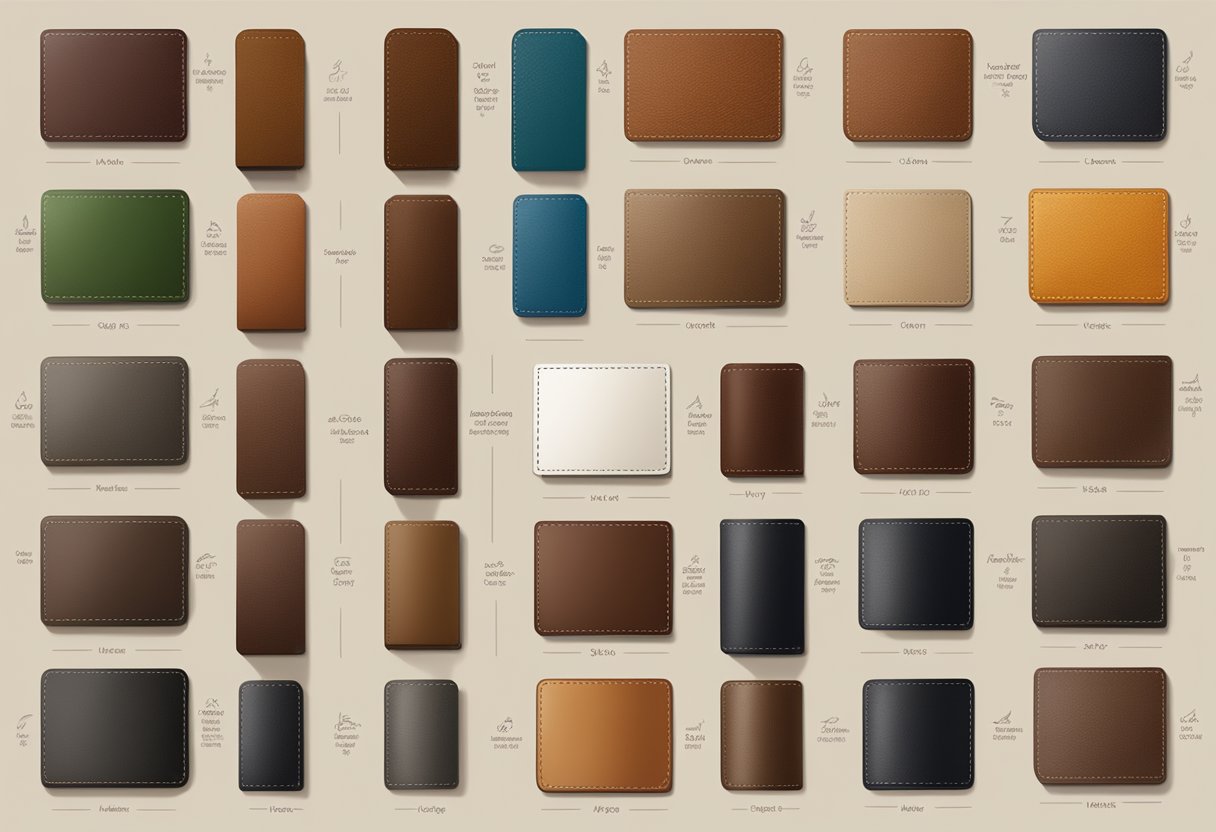Types Of Leather
Leather is a popular material used in various industries, including fashion, upholstery, and automotive. It is a durable and versatile material that comes in different types and grades. Understanding the different types of leather is essential for choosing the right material for a specific project or purpose.
There are several types of leather, including full-grain, top-grain, genuine, bicast, and bonded leather. Each type has its unique characteristics, grades, and finishes. Full-grain leather is the highest quality and most expensive type of leather, while bonded leather is the least expensive and lowest quality. Understanding the differences between these types of leather is crucial for selecting the right material for a particular project.
When it comes to leather quality, there are several factors to consider, such as the animal source, hide layer, tanning method, and finishing. These factors affect the texture, strength, and durability of the leather. Identifying and caring for leather is also crucial for maintaining its quality and prolonging its lifespan. Knowing how to identify and care for different types of leather is essential for preserving their beauty and functionality.
Key Takeaways
- There are several types of leather, including full-grain, top-grain, genuine, bicast, and bonded leather.
- Leather quality depends on several factors, such as the animal source, hide layer, tanning method, and finishing.
- Identifying and caring for leather is crucial for maintaining its quality and prolonging its lifespan.
Types and Grades of Leather

Leather is a durable and versatile material that can be used for a variety of purposes, from fashion accessories to furniture upholstery. There are several types and grades of leather available in the market today, each with its unique characteristics and qualities. In this section, we will discuss the most common types and grades of leather.
Full-Grain Leather
Full-grain leather is the highest quality of leather available. This type of leather is made from the top layer of the hide, which is the most durable and strongest part of the animal’s skin. The grain, or natural pattern of the hide, is left intact, giving the leather a natural and unique appearance. Full-grain leather is also the most breathable and comfortable to wear. It is commonly used in high-end leather products such as luxury bags, shoes, and belts.
Top-Grain Leather
Top-grain leather is the second-highest quality of leather. It is made from the top layer of the hide, but the grain is sanded off to remove imperfections and blemishes, giving the leather a more uniform appearance. Top-grain leather is still durable and comfortable to wear, but it is not as breathable as full-grain leather. It is commonly used in furniture upholstery, jackets, and wallets.
Split Leather
Split leather is made from the lower layers of the hide that are separated from the top layer during the tanning process. It is less durable and less expensive than full-grain and top-grain leather, but it is still a good quality leather. Split leather is commonly used in the manufacturing of suede, as well as in furniture upholstery and handbags.
Bonded Leather
Bonded leather is made from scraps of leather that are bonded together with a polyurethane or latex adhesive. It is the lowest quality of leather and is not as durable or comfortable as full-grain or top-grain leather. Bonded leather is commonly used in the manufacturing of low-cost furniture and accessories.
In conclusion, understanding the different types and grades of leather is essential when choosing leather products. Full-grain leather and top-grain leather are the highest quality and most durable, while split leather and bonded leather are less expensive but less durable.
Characteristics of Leather
Leather is a popular material that has been in use for centuries. It is made from the hides of animals such as cows, goats, and sheep. Leather has a unique set of characteristics that make it desirable for a variety of applications. In this section, we will discuss some of the key characteristics of leather.
Texture and Finish
Leather has a natural texture that is determined by the animal it comes from. The texture can be smooth, rough, or somewhere in between. The finish of leather can also vary, from a high gloss to a matte finish. The finish is often determined by the intended use of the leather. For example, leather used for furniture may have a high gloss finish to make it more durable and resistant to wear and tear.
Durability and Strength
Leather is known for its durability and strength. It is able to withstand a lot of wear and tear, making it an ideal material for products that are used frequently. The strength of leather is determined by the quality of the leather and the tanning process used to make it. Full-grain leather is the strongest and most durable type of leather, as it is made from the top layer of the hide.
Thickness and Flexibility
The thickness of leather can vary depending on the intended use of the leather. Thicker leather is more durable and resistant to wear and tear, while thinner leather is more flexible and easier to work with. Leather can also be treated to make it more flexible or stiffer, depending on the intended use.
When it comes to leather, natural imperfections are to be expected. These imperfections can include scars, stretch marks, and insect bites. These imperfections are often seen as desirable, as they add character to the leather and make it unique.
The grain and corium junction is an important aspect of leather. The grain is the top layer of the hide, while the corium is the layer below the grain. The junction between these two layers is where the strength of the leather comes from. The junction is also where the natural texture of the leather comes from.
Leather qualities can vary depending on the type of leather and the tanning process used. Full-grain leather is the highest quality leather, as it is made from the top layer of the hide. Top-grain leather is also of high quality, but it is made from the second layer of the hide. Genuine leather is made from the third layer of the hide and is of lower quality than full-grain or top-grain leather.
In conclusion, leather has a unique set of characteristics that make it a desirable material for a variety of applications. Its texture, durability, strength, thickness, and flexibility can all be customized to meet the needs of different products. Natural imperfections and the grain and corium junction add character to the leather, while the quality of the leather is determined by the type of leather and the tanning process used.
Leather Tanning and Finishing
Leather tanning is a critical process in leather production that involves the treatment of raw hides and skins to produce leather. Tanning helps to preserve the hides and skins, making them durable and resistant to decay. There are different types of leather tanning methods, including vegetable tanning, chrome tanning, and chrome-free tanning.
Aniline and Semi-Aniline Leather
Aniline and Semi-Aniline leather are types of leather that are tanned with aniline dyes. Aniline leather is a type of leather that is tanned with aniline dyes and does not have any surface coating or pigmentation. As a result, it retains the natural texture and markings of the hide. Semi-Aniline leather, on the other hand, is tanned with aniline dyes and has a light surface coating that provides some protection against stains and wear.
Pigmented and Embossed Leather
Pigmented and Embossed leather are types of leather that have a surface coating or pigmentation. Pigmented leather is tanned with pigments that create a uniform color and texture. This type of leather is more resistant to wear and staining than aniline leather. Embossed leather is also tanned with pigments but has a pattern or texture embossed onto the surface of the leather.
Specialty Finishes
There are different types of leather finishes that can be applied to leather to enhance its appearance and durability. Nappa leather is a type of full-grain leather that is soft and supple, making it ideal for luxury goods such as handbags and wallets. Suede leather is a type of leather that has a soft, fuzzy surface created by buffing the underside of the hide. Other specialty finishes include waxed leather, pull-up leather, and metallic leather.
In conclusion, understanding the different types of leather tanning and finishing methods can help you choose the right leather for your needs. Whether you prefer the natural texture and markings of aniline leather or the durability of pigmented leather, there is a type of leather that is perfect for your project.
Leather in Fashion and Upholstery
Leather has been used in fashion and upholstery for centuries. It is a versatile material that provides both style and functionality. There are many different types of leather available, each with its own unique qualities. In this section, we will explore how leather is used in fashion and upholstery and the benefits it provides.
Style and Elegance
Leather is a timeless material that adds style and elegance to any outfit or piece of furniture. Nappa leather, for example, is a soft and luxurious leather that is often used in high-end fashion items such as jackets, handbags, and shoes. Its fine grain and soft texture make it a popular choice for those who want to add a touch of sophistication to their wardrobe.
In upholstery, leather is often used in furniture pieces such as sofas and armchairs. Its natural texture and rich color provide a classic and elegant look that is hard to replicate with other materials. Suede leather, on the other hand, is a softer and more delicate type of leather that is often used in decorative upholstery pieces such as cushions and curtains.
Comfort and Protection
Leather is not only stylish but also provides comfort and protection. Leather jackets, for example, are popular because they provide warmth and protection from the elements while still looking fashionable. Leather gloves are also a popular choice for those who want to keep their hands warm while still maintaining dexterity.
In upholstery, leather is a popular choice because it is durable and easy to clean. Faux leather is a popular alternative to real leather because it is more affordable and easier to maintain. It is often used in commercial settings such as restaurants and hotels because it is resistant to stains and spills.
In conclusion, leather is a versatile material that provides both style and functionality. Whether you are looking for a fashionable leather jacket or a durable leather sofa, there is a type of leather that will meet your needs.
Identifying and Caring for Leather
Leather is a natural material that requires careful handling and maintenance to ensure its longevity. Here are some tips on how to identify and care for leather.
Authenticity and Quality
When purchasing leather, it is important to ensure that it is authentic and of good quality. Authentic leather should have a distinct smell and feel. It should also have a natural grain pattern that is visible to the eye. The quality of leather can vary depending on the type of animal hide used and the tanning process. Full-grain leather is considered the highest quality as it retains the natural grain pattern and is the most durable. Top-grain leather is also of good quality but has had the top layer sanded down. Bonded leather, on the other hand, is made from scraps of leather that have been bonded together with adhesive and is of lower quality.
Maintenance and Longevity
To ensure the longevity of leather, it is important to protect it from scratches and stains. A protective barrier, such as a leather conditioner or wax, can be applied to the leather to help prevent damage. Leather should also be kept away from direct sunlight and heat sources as this can cause it to dry out and crack.
Regular cleaning and conditioning of leather is also important to maintain its quality and appearance. A leather cleaner can be used to remove dirt and stains, while a leather conditioner can be used to keep the leather supple and prevent it from drying out. It is important to follow the manufacturer’s instructions when using these products to avoid damaging the leather.
In conclusion, identifying and caring for leather is crucial to ensure its longevity and maintain its quality. By following these tips, leather can be enjoyed for years to come.






